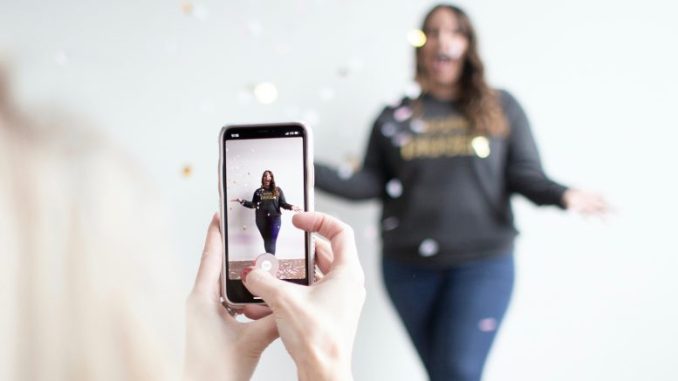
By Acsah Lemma
TikTok plays a big part in American culture, says Hassan Khadair, a TikTok influencer. In fact, he says, the social media platform is “now integral” to our cultural systems.
“It informs culture in so many different ways, from food culture, to music culture, to products and services and actors and movies and TV shows,” he says.
Like Khadiar notes, the monolith that is TikTok has made its way into almost every aspect of society since its launch in 2018 — and now people have begun to see the effects. Although TikTok is marketed to people of all different age ranges and backgrounds, with its pinpoint algorithm that forms a “for you page” specific to its users, Generation Z (people born between 1997 and 2012) are the majority of the user base, according to Forbes.
Ariana Aguilar, a substitute teacher in Sacramento, says when she was a high school student from 2015 to 2019, YouTube was the most popular app for students to use in between classes. Now when she teaches in high schools she says that TikTok is what she sees all the students using when they have free time.
Penile Kumalo, a recent graduate from Mira Loma High School in Arden-Arcade, joined TikTok like so many others in March of 2020. With the pandemic keeping everyone inside, she turned to the social media app for her source of entertainment. Kumalo called TikTok a “modified version of YouTube,” saying that because the videos are way shorter, it’s easier to keep one’s attention on the content. The average TikTok video from a “huge account” (more than 25,000 views) is 42 seconds, according to Statista.
But now as an incoming freshman in college, Kumalo says she struggles when it comes to staying focused on schoolwork and has to actually hide the app on her home screen so that when her fingers feel the urge to scroll, the extra work to find the app on her phone will keep her from losing focus.
University of Southern California professor in applied psychology Julie Albright describes TikTok as similar to gambling in a recent interview with Forbes. “You keep scrolling, she says, because sometimes you see something you like, and sometimes you don’t. And that differentiation — very similar to a slot machine in Vegas — is key.”
This can have a damaging effect on younger brains that are still developing. “Our brains are changing based on this interaction with digital technologies and one of these is time compression,” Albright shared in the Forbes story. “Our attention spans are lowering.”
Science Direct reports that “The average attention span seems to be lessening as students quickly get frustrated and ask for help before attempting to thoroughly read the supporting text and work through practice sets provided by the instructor.” Not only is this affecting a student’s ability to learn effectively, but also the way they think and act.
“TikTok gives you a lot of instant gratification,” Khadair says. “Each scroll gives you a dopamine response. … You’re getting a video that is hyper fixated towards a topic that you care about, that [the algorithm] thinks you care about, or that leads you to caring about it.”
Khadair, who is 24, has more than 6.3 million followers on TikTok. Originally on Vine, he blew up on TikTok from reposting his old content and is now known for his videos where he does impressions of Mickey Mouse reacting to various different types of videos.
“When you’re that young and training your brain to think that all I need to do to get dopamine is to do this all day every day, it’s a lot harder to get kids like that, especially COVID-years kids to [pay attention],” he added.
Khadair was on multiple social media apps at their humble beginnings, including YouTube, Vine and TikTok. When he first joined TikTok in 2019, he said that trends lasted much longer. Popular jokes or memes would last months with the majority of a user’s “for you page” playing into that trend. Now he says that you’ll scroll past a TikTok about a previous viral trend and feel nostalgic for that time, but “it was only three weeks ago and it [the trend] was only around for two days.”
A dwindling attention span is not only reflected in the patterns of the app, but also in the ability to focus in a classroom. Aguilar shares that when planning lessons for her high school students she needs to take into account their attention span.
“That’s a pretty big thing to take into consideration when making lesson plans, like how am I going to get their attention? Well, not only get attention, but also sustain their attention span,” she says. Aguilar employs interactive platforms into her lessons such as Kahoot — a game-based learning platform — in an effort to keep her students engaged.
Although some young students are the ones noticeably showing the effects, they are not alone in their shortened attention span. Zach Taddese, a 24-year old Sacramento native who now works as a hardware engineer based in the Bay Area, says he originally refrained from joining the app, but was eventually tempted and downloaded it after seeing the sheer amount of content it had.
Although he sees the benefits of the app, he shared that now since he’s so used to seeing so many small clips he “gets frustrated when there are clips that take longer than 2 minutes,” Taddese says. “I end up scrolling to the comments to keep my mind stimulated while I finish the rest of the TikTok.”
This story was done in collaboration with Sacramento City College’s journalism department.

Be the first to comment